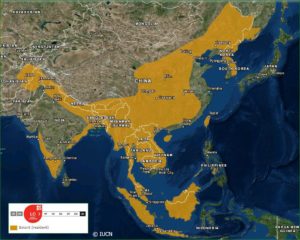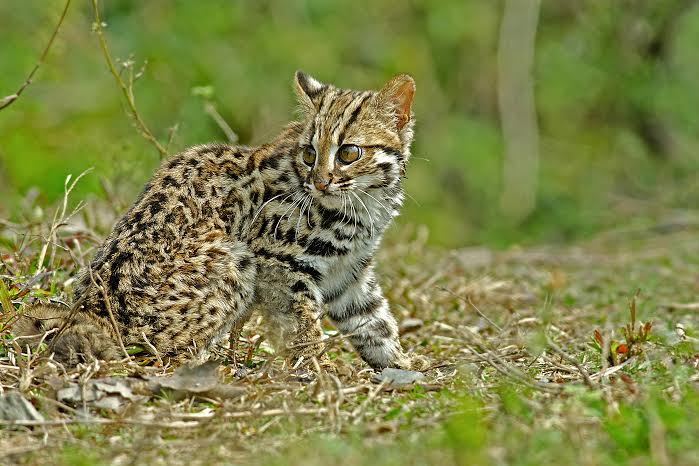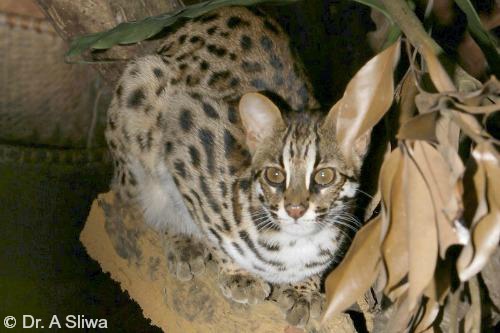- HB Length: 45-75 cm (18-29″)
- Tail Length: 19-31 cm (7.4-12″)
- Height: Approx 41 cm (16″)
- Weight: 1.7-7 kg (4-15 lbs)
- Pop. Trend: Stable
The most widespread of all small Asian felids, the Leopard Cat Prionailurus bengalensis is about the size of a domestic cat, but rather long in the legs. They vary widely in size and appearance across their range. Colouration ranges from pale tawny, to yellow, red or grey above, with the underparts white, and spotted. Black rosettes cover the sides of the body, with solid spots running down the legs and the tail. There are usually four black stripes running down the forehead to the nape, breaking up into short bands and elongate spots on the shoulders. Often there is one stripe running the length of the body. The length of the fur is variable according to their habitat, with those cats in the most northern part having longer, thicker coats than the southern subspecies.
The relatively small head has a short, narrow muzzle, a white chin, and two narrow, black cheek stripes enclosing a white area. Two white and four black stripes run up from the inner corners of the eyes towards the ears. The irises are a deep, golden brown to greyish, and the long, rounded ears are black on the outside, with a white central spot. The tail is spotted above with a few indistinct spotted rings near the buff coloured tip.
Distribution

The Leopard Cat occurs throughout most of India, west into Pakistan and Afghanistan, into the Himalayan foothills, across most of China, and north to the Korean peninsula and into the Russian Far East. It is found in most of Southeast Asia: Thailand, Vietnam and China; and on the islands of Sumatra, Java, Borneo and Taiwan as well as on small islands off South Korea (Tshushima islands; Cheju island) and the Philippine islands of Palawan, Panay, Negros, Cebu and possibly also Masbate. The leopard cat is the only wild cat species native to Japan and the Philippines. The smallest subspecies are found in the jungles of the Philippines, with the largest cats being found in the northern regions. There are currently 11 recognized subspecies.
In the deep forests of Thailand, radio telemetry studies determined home range size to be 2.5 – 5.4 km², with male ranges enclosing that of several females. They utilize habitat uniformly, with a marginal preference for riverine habitat and roads. The highest levels of activity took place during the wet season, with much lower levels in the dry season. Marked differences in home range sizes, activity and prey selection were found in drier mixed habitat.
Other studies have revealed home range sizes averaging 12.7 km² in a Thailand protected area and 3.5 km² on the island of Borneo.
Male ranges generally overlap numerous smaller female ranges. Overlap between same-sex adults is considerable at the edge of their ranges but minimal in the core territory. Density estimates vary from 34 cats/100 km² on Iriomote Island to 37.5/100 km²
in Sabah, Malaysia.
Habitat
They inhabit forests and jungles in both low country and in hilly, even mountainous areas up to 3,254 metres, as well as scrub, semi-desert, secondary vegetation and agricultural areas. In northeastern Asia they are often found in pine forests, favouring the more open stretches that have plenty of fallen trunks. They avoid open grassland and steppes, but are willing to live near humans if not persecuted. On Borneo, they can be found in the great caves, scavenging swiftlets as the baby birds fall from their nests on the walls.
The Leopard Cat seems to be more tolerant of deforestation and habitat alteration than other Asian felids, with the exception of the Jungle Cat Felis chaus. They also use degraded forest and modified habitats such as oil palm plantations, secondary forest and farmland. It is possible that these areas are used for hunting because of high prey abundance such as rats.
This cat occurs over a wide elevation range, from sea level to >4,000 m elevation in the Himalayas. In eastern Nepal, a cat was pictured at 3,254 m elevation and in Kangchenjunga Conservation Area, Nepal, a Leopard Cat was detected with camera traps at 4,474 m elevation.
Ecology
The Leopard Cat is a solitary species but has been observed in pairs or with dependent young. It is mainly described as nocturnal and crepuscular. However, they can also be active during the day with males showing more diurnal activity than females.
They use forests and understory for resting and breeding, and hunting is done both on the ground and in trees.
Most of their hunting is done at night, but their activity levels vary widely depending on the habitat. Like most wild cats, they swim very well and are able to colonize close off-shore islands. Showing little aversion to human presence, Leopard Cats can frequently be found close to villages, and have been kept as rodent control agents by villagers. They are also known to raid domestic poultry. Legend says they catch birds by dropping on them from above, and like most small cats they are very agile in the trees.
In Borneo Leopard Cats have been found preying on the high density of rats in palm oil plantations but retired to forest fragments to sleep and breed. A Korean study identified their diet to be 90% rodents, with a high percentage of plant matter also eaten.
Reproduction
This wide ranging species has variable breeding seasons. Leopard Cats from the northern part of their range bear their young in May, but in warmer southern parts kittens have been found at all times of the year. After a gestation of 65 – 70 days, one to four, usually two or three, young are born in a hollow tree, rocky crevice or burrow. Weight at birth is around 80 grams; their eyes open in 5 – 15 days. Sexual maturity is reached around 8-12 months. Captive animals have been known to live over 15 years.
Threats
- habitat loss
- hunting and killed as a poultry predator
- caught in snares set for other species
- higher mortality in areas with greater human activity
- populations in India fragmented
- heavy commercial exploitation in China for fur, meat and the pet trade
- commercial fur trade
Conservation
Leopard cat population status and trends are unknown. They appear to be relatively common and widespread with stable populations as indicated by relatively frequent detection during camera trap studies in different habitats.
Survival rates of 92% have been recorded in a protected area with little human disturbance compared to 53-82% in areas with greater human activity. Hybridization with feral domestic cats has been reported but is not considered a significant threat.
In China, commercial exploitation has been heavy in the past. In the 1980s several hundreds of thousands of furs per year were exported. The average number of furs per year was 150,000 from 1955 to 1981. Chinese exports of leopard cat furs were halted in 1993. The impacts of such a continual harvest are unknown.
Leopard Cats are heavily persecuted for the commercial fur trade in their temperate range. Japan is the major cat fur consumer in Asia, and Leopard Cat skins are their primary choice, importing as many as 50,000 skins per year.
Further research is needed to determine both the taxonomic and conservation status of the Leopard Cat. Although it seems to be tolerant of different types and levels of habitat disturbance, the degree of this tolerance is currently unknown and must be researched.
See also Iriomote Cat

Range Map IUCN Red List (2008)
Updated 2018


Pat Bumstead
If you’re looking for an author reference, just use ISEC Canada. All of our fact sheets have been written by members of our board of directors. The information is taken from the IUCN Cat Specialist group at catsg.org.
Victoria
Can I have an author’s name?
Pat Bumstead
No one knows how many leopard cats there are in the wild. It is impossible to count a small wild cat that ranges over most of eastern Asia.
shimmercattie
umm….. i’m not so sure about how many leopard cats are they left now….. could u provide me with the information?
Jim Jacobs
The uninhabited DMZ between North and South Korea is an ideal place or them where they live undisturbed. During the Korean War my colleagues and I occasionally saw them at night. The probably found good pickings in discarded military ration cans.
Pat Bumstead
Totally agree!
Liz
I am astounded that any country, particularly Japan with traditional values, sees such diverse and incredibly beautiful wildlife as a “resource”, these valuable creatures of which there are many sub species need protection from such ignorance just like many of the larger cats where human greed, overpopulation and stupidity continue to push them to the brink. For Japan/China to want to increase their “quota” of wildcats taken from the wild for their skins by a further “500%” is abhorrent! It is also unethical unsustainable, shortsighted and violates the environment still further. Where human activity/influence destroys one species without carefully checking and re-checking the consequences, other species will suffer including plant life. Why are so many human beings so ignorant, so selfish, so callous. These animals are part of a natural eco system, humans have taken most fragile beautiful places close to the edge and in many cases destroyed them beyond recovery, grow up you fools, animals are not a resource, these are living breathing vital cogs in the wheel of life which affect us all. See the beauty and wonder in front of your incredibly short sighted eyes, value the diversity of life this life giving planet offers and stop breeding like flies and corrupting the world we all share with an unprecedented amount of offspring. The world and its wildlife belongs to all, our children and their children, not just to the greedy, cruel, stupid, money grabbing fur traders. You should all hang your head in shame for your part in the decimation of such iconic and staggering beautiful diverse creatures humans share this world with.
Starburst
Which types of wild cats, if any, live in Krabi in Thailand? Any in Phuket?
Sabine Danelon
THEY ARE MAJESTIC !! WILD CATS HAVE A RIGHT TO LIVE IN PEACE
Protect the Leopard Cats in Taiwan · Global Voices
[…] in Taiwan. Since the big cats live in the forests and jungles in both plains and in hilly areas and their home range is very broad, their habitats in Taiwan are easily disturbed by new construction projects. The Taiwanese […]